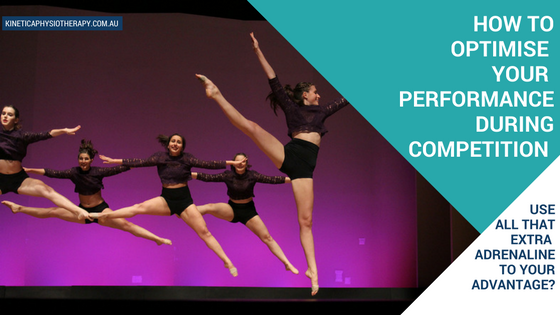We all know the feeling. You’ve rehearsed your piece one hundred times. You know the music, the choreography, and the timing backwards. You could do this in your sleep right? So why is it that in those few moments before you enter the stage that your heart suddenly wants to jump out of your chest, your mouth feels dry, you can’t swallow, and your legs turn to jelly? This didn’t happen in rehearsal!!
Don’t panic. This feeling which we call ‘nerves’ is actually caused by a surge of the hormone adrenaline into our system. This increase in adrenaline in our body occurs when our brain senses that we are about to undertake something rather stressful and demanding. For our ancestors, this may have been that they were being chased by a bear or about to fight a warring tribe. The adrenaline would have shot into their systems forcing their heart rate to increase, their breathing to become more rapid, their blood to be forced to their arms and leg muscles to allow them to run more efficiently, and their digestive processes would slow down leaving their mouths dry. No one needs to bother with digesting their breakfast when they are at risk of becoming one right! This bodily response is called ‘the fight or flight response’ because it was extremely effective in preparing our ancestors to undertake both of those things.
These days we have the same response whenever our brains sense that we will be expected to act under pressure. Generally, this increase in adrenaline is good. We can jump higher, and run faster when adrenalin is pumping through our bodies. In performance however, we know that too much adrenaline can be detrimental. You see, with this increase in power, we can lose some of our ability to coordinate movement, and are less able to look relaxed and in control. Optimally we want an increase in adrenaline, but not too much so that we lose our ability to perform to an audience.
So how do we optimise this surge in adrenaline? Sound impossible? Not so! There is a trick to controlling our adrenaline so that it works for, and not against us!!!
When adrenaline is forced into our system, we know that our heart rate increases and our breathing becomes more rapid and shallow. So what if we purposely slow down our breathing?? When we breathe slowly and deeply, we trick our brain into thinking that ‘things aren’t so stressful afterall’, and what happens? Our heart rate decreases, and our muscles relax slightly. Try it! Feel for your pulse at your wrist or at the side of your neck, just below your jaw line. Now, slow your breathing right down. Even hold your breath for a few seconds … you should feel your pulse slow slightly. You will see doctors and paramedics do this whenever they treat someone who is in shock. They will lie them down and ask them to breathe slowly and deeply. It works!
The other thing that will help you to prepare your body as you wait in the wings is to keep your muscles warm, so that they are ready for the sudden increase in activity as you run onto stage. You should have already completed a thorough warm up that includes both dynamic exercises (circling your joints, barre exercises, and light aerobic exercise such as small jumps and runs) as well as static stretches for all your muscle groups. By the time you are waiting in the wings, your only concern should be keeping your muscles warm. This is best done by small repetitive movements, and not by sustained stretches. Recent research now shows that muscles that have been stretched immediately before performance are more likely to be injured than those that are kept warm with small repetitive movements. For example, rises and plies in 1st position to keep your ankles warm, gentle rotations side to side through your lower back, and leg swings at the barre for your hips. If in doubt as to which warm up exercises will work well for you, contact your favourite dance physiotherapist who can advise you appropriately.
Finally, remember. Every adjudicator on the judging panel was once, or is a dancer themselves. And they know the difference between nerves, and poor technique. So let your nerves work for you! Prepare well, keep yourself warm in the wings, take a deep breath, and be confident in your ability. You never know, the extra adrenaline may mean that you’ve never danced so well. Good luck.
This article was first published in BODYWISE.
Image Credit:
- Main Image – dailyfreepress.com

